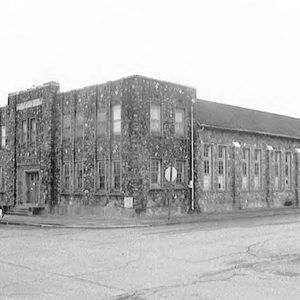calsfoundation@cals.org
Mena National Guard Armory
The Mena National Guard Armory at 619 DeQueen Street in Mena (Polk County) is a single-story, Art Deco–style, fieldstone-clad structure built in 1930. It was listed on the National Register of Historic Places on June 5, 1991.
Citizen-soldier militias have had a constant presence in the United States since the colonial era, but it was not until Congress passed the Dick Act—sponsored by Senator Charles W. F. Dick, chairman of the Committee on the Militia—in 1903 that the National Guard became an official partner in the nation’s armed services, receiving federal support for training, equipment, and pay. Arkansas’s state militia was organized into the Arkansas National Guard as a result of the Dick Act.
Seventeen armories—including the Marianna National Guard Armory, Pine Bluff National Guard Armory, Batesville National Guard Armory, Hot Springs National Guard Armory, and Mena National Guard Armory—were constructed as part of a statewide armory building program that was authorized by state Act 271 of 1925, which created a “Military Fund” to be used in the construction of armories. After the Great Depression hit Arkansas, most armory building was done through such New Deal agencies as the Works Progress Administration (WPA). Most of those armories reflect a restrained version of the Art Deco style of architecture.
In January 1930, a group of Mena citizens led by Chester Lauck of Lum and Abner fame met with Assistant Adjutant General Charles S. Garrett of the state Military Department to discuss building a new armory in Mena to house Battery D, 142nd Field Artillery, Fifth Arkansas Infantry Regiment, on a site donated by the citizens of Mena. An Arkansas Gazette article on the meeting noted that “the Military Department is authorized to construct three armories a year in cities where units of the organization are located permanently.” By April, the project was approved, and Durwood F. Kyle of Pine Bluff (Jefferson County), the Military Department’s architect, designed the structure, for which the department would contribute $20,000 for a “brick and concrete building.” Walter W. Vernon of Fort Smith (Sebastian County) made the initial low bid of $27,750 for the building, while John Patton of Morrilton (Conway County) won the heating contract for $800.
The final contract to Vernon was for $22,634, which included lighting, plumbing, and heating fixtures; it was delayed “to permit the architect to make minor changes in the plans for a structure of field stone instead of brick,” a change that Kyle approved after meeting with local citizens. Construction began on May 12, 1930, and, with one brief work stoppage while Kyle investigated the work site in June “after rumors had become current that the foundation had been improperly constructed,” the building was completed by December.
The Mena National Guard Armory was dedicated on December 11, 1930, at a meeting of the Polk County Possum Club with Lauck as master of ceremonies. The 310 people in attendance, who were served a banquet of “possum and sweet taters,” heard several speeches, including one by National Guard Adjutant General E. L. Compere, who described the new building as “one of the most beautiful armories in the state.”
While most National Guard armories in Arkansas were constructed of buff brick, the Mena building was unusual in its use of native stone. As the National Register nomination stated, “The Mena armory…due to its reliance solely upon the texture and random linearity of the fieldstone for its ornament, exploits thereby the medieval aspect lent the design by the castellated parapet and the wall buttresses. The end result is an armory that, though not nearly as architecturally sophisticated as the fancier, more erudite Art Deco designs elsewhere in the state, presents a far more formidable and permanent aspect to the viewer.”
The National Guard used the building for many years before moving to a new armory. In 2004, Rich Mountain Community College (which later became the University of Arkansas Rich Mountain) acquired the Mena National Guard Armory and restored it for use as a special events venue. In 2019, the college received a $204,644 grant from the Arkansas Natural and Cultural Resources Council to finance critical repairs at the old armory, which is used by the college, for community purposes, and by numerous local sports teams.
For additional information:
“Armory for Mena Discussed.” Arkansas Gazette, January 18, 1930, p. 8.
“Armory Bids Received.” Arkansas Gazette, April 13, 1930, p. 8.
“Contract for Building Armory at Mena Awarded.” Arkansas Gazette, April 11, 1930, p. 2.
Hope, Holly. An Ambition to be Preferred: New Deal Recovery Efforts and Architecture in Arkansas, 1933–1943. Little Rock: Arkansas Historic Preservation Program, 2006. Online at http://www.arkansaspreservation.com/News-and-Events/publications (accessed December 11, 2020).
“Mena Armory Dedicated at Possum Club Banquet.” Arkansas Gazette, December 12, 1930, p. 9.
“Mena National Guard Armory to Be Built of Native Stone.” Arkansas Gazette, May 9, 1930, p. 4.
“Mena to Have Armory.” Arkansas Gazette, April 9, 1930, p. 10.
“New National Guard Armory at Mena Built of Ouachita Mountain Stone.” Arkansas Gazette, December 20, 1930, p. 2.
“State News in Brief.” Arkansas Gazette, June 28, 1930, p. 14.
Story, Kenneth. “National Guard Armory.” National Register of Historic Places registration form. On file at Arkansas Historic Preservation Program, Little Rock, Arkansas. Online at http://www.arkansaspreservation.com/National-Register-Listings/PDF/PL0104.nr.pdf (accessed December 11, 2020).
Sutherland, Cyrus, et al. “Historic National Guard Armory.” Society of Architectural Historians Archipedia. https://sah-archipedia.org/buildings/AR-01-PL3 (accessed May 13, 2022).
“UA Rich Mountain Awarded $200+K Grant from ANCRC.” University of Arkansas Rich Mountain. https://www.uarichmountain.edu/news/armory-grant (accessed May 13, 2022).
Mark K. Christ
Central Arkansas Library System
 Early Twentieth Century, 1901 through 1940
Early Twentieth Century, 1901 through 1940 Historic Preservation
Historic Preservation Military
Military National Guard Armory [Mena]
National Guard Armory [Mena]  National Guard Armory [Mena]
National Guard Armory [Mena] 



Comments
No comments on this entry yet.